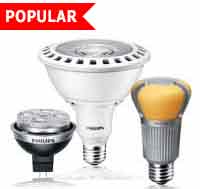Dimmable CFLs: Are they Really a Bright Idea?
As CFLs storm the lighting world, one sustained criticism of them has been that they cannot dim like incandescent bulbs. This was true when magnetic ballasts were the sole ballast technology for CFLs, but as electronic ballasts have become the standard,dimmable CFLs are now on the market, though not in as large numbers as non-dimmable CFLs. In this article I will take a look at the pros and cons of dimmable CFLs versus dimmable incandescent bulbs and help you decide whether they are worth your money. But first, I think it would be helpful to understand exactly how a dimmer works with an incandescent bulb, and why it is problematic when applied to a CFL. The concept of dimmer is simple, it simply reduces the voltage to the bulb and the bulb’s brightness increases or decreases accordingly. In an incandescent bulb this method of dimming works well because the reduction in voltage simply reduces the amount heat given off and therefore reduces the amount of light as well. This doesn’t work in CFLs because CFLs generate light by exciting a gas, which then yields light. If you cut the amount voltage the CFL receives it will more often than not simply go out because there is not sufficient current to excite the gas.Today dimmable CFLs are offered by GE, SunLite, and Ushio among other manufacturers. Though dimmable CFLs are certainly an innovation, there are certain limitations to these bulbs. First, dimmable CFLs do not usually dim below 10%-20% brightness because the bulb cannot sustain light at that point. Another complaint surrounds the fact dimmable CFLs, and all CFLs for that matter, can take up to a minute to reach full brightness. This means that you cannot dim the bulb until it has reached full luminosity. Lastly and most importantly, there are limitations regarding the type of dimmer you can use with your CFL. As a rule of thumb never use photo cells or timers with any CFL unless you can do so as indicated on the bulb’s packaging. Dimmers are built to work within a certain power range. Dimmers that are designed for primarily incandescent bulbs, and especially older dimmers, will be engineered to work with wattages above 40w, this is too great for dimmable CFLs and could be problematic. More recent dimmers, particularly those released in the 1990s, have a wider wattage range and are therefore most likely compatible with your dimmable CFL. The point is that if possible, you try to find out what type of dimmer you have and what its range is before you dim your dimmable CFL. One final point is that as incandescent bulbs are dimmed their color temperature typically gets warmer and more ambient; this is not really the case with CFLs. The benefits to dimmable CFLs, however, are that they are more efficient and longer lasting and better for the environment. It is also likely that as the incandescent bulb phase-out approaches dimmable CFL technology will only improve, and rapidly. Dimmable CFLs will save you significant amounts of energy and you will not have to change your light bulb as often as if you use incandescent bulbs.
BulbAmerica has a wide selection of dimmable CFLs and regular CFLs in addition to other energy saving lighting products. We also have many, many dimmers. Check out what we have to offer!

















Comments